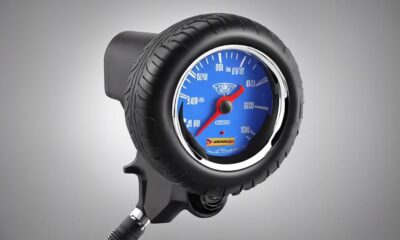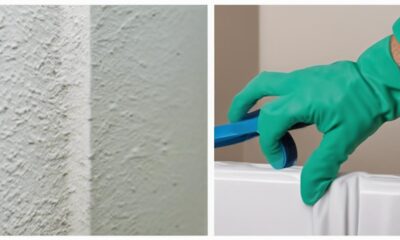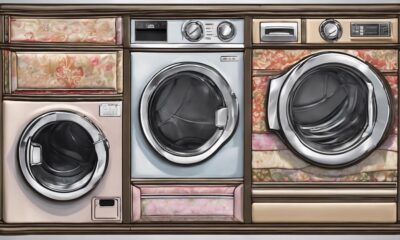Appliances
Paint for Denim
2025

When it comes to painting denim, many individuals are unaware of the existence of specific types of paint specifically formulated to stick to this distinctive fabric.
We've all seen the stunning custom designs on denim jackets and jeans, but what many don't know is the level of skill and technique that goes into creating these wearable works of art.
Whether you're a seasoned painter or just starting out, there's a whole world of possibilities when it comes to transforming your denim pieces into personalized masterpieces.
So, if you've ever wondered how to take your denim to the next level with paint, stick with us as we explore the ins and outs of this creative endeavor.
Key Takeaways
- Choose paints specifically formulated for fabric and denim
- Prioritize paint durability and colorfastness for long-lasting artwork
- Understand color mixing to create a unique palette
- Wash denim fabric to remove dirt, oils, and sizing before painting
Types of Paint for Denim
When painting denim, it's important to choose the right type of paint for the best results. Paint durability is crucial, especially considering the wear and tear denim garments typically undergo. For this reason, it's essential to select paints specifically formulated for fabric and, ideally, for denim. These paints are designed to withstand frequent washing and the rigors of daily use, ensuring that your artwork remains vibrant and intact over time.
Colorfastness testing is another key factor to consider when choosing paint for denim. This testing assesses the paint's ability to retain its color over time and through exposure to various conditions, such as washing and sunlight. Opting for paints that have undergone rigorous colorfastness testing will help maintain the integrity of your designs, preventing them from fading or bleeding onto other fabrics.
As denim is a sturdy and often heavily used fabric, it's essential to prioritize paint durability and colorfastness when selecting the right type of paint for your denim projects. By choosing high-quality, tested paints, you can ensure that your artistic creations on denim remain vibrant and long-lasting. Additionally, preparation is key to achieving the best results—washing and drying the denim beforehand helps the paint adhere more effectively. The best fabric paints for denim are typically acrylic-based and specifically designed for textiles, as they provide flexibility and resist cracking over time. With the right tools and techniques, your customized denim pieces can withstand regular wear and washing while maintaining their bold colors and intricate designs.
Choosing the Right Colors

Selecting the appropriate colors is essential when painting denim to achieve the desired aesthetic and visual impact. When choosing the right colors for your denim painting, consider the following:
- Color Mixing: Understanding color theory and how different hues interact with each other is crucial. Experimenting with mixing primary colors to create a unique palette can elevate the vibrancy and depth of your artwork. For instance, blending blue and yellow can produce various shades of green, offering a wide spectrum of tones to work with.
- Artistic Inspiration: Seek inspiration from the world around you. Nature, art, and everyday objects can provide a wealth of color combinations and palettes to incorporate into your denim painting. Whether it's the warm earthy tones of a sunset or the cool blues of a tranquil lake, drawing from real-life color schemes can infuse your artwork with authenticity and emotional resonance.
- Color Psychology: Delve into the psychology of color to understand the emotional and visual impact different colors can have on the viewer. By strategically incorporating colors that evoke specific moods or feelings, you can create a more impactful and meaningful artwork that resonates with your audience.
Preparing Your Denim for Painting
We typically start by prepping the denim fabric, ensuring it's clean and free of any wrinkles or creases that could affect the painting process. Denim washing is crucial before painting to remove any dirt, oils, or sizing that may be present on the fabric. This can be done by hand-washing the denim with a gentle detergent or running it through a delicate cycle in the washing machine. Once clean, it's important to thoroughly dry the denim to ensure the paint adheres properly.
After washing, fabric priming becomes the next essential step. Priming helps create a smooth surface for the paint to adhere to, preventing it from bleeding or spreading unevenly. Choose a fabric primer specifically designed for denim to ensure the best results. Apply the primer evenly over the denim surface and allow it to dry completely before starting the painting process.
Essential Painting Techniques

After prepping the denim fabric and ensuring it's clean and free of any imperfections, we can now focus on mastering essential painting techniques that will enhance the overall look and longevity of the design. To achieve a professional finish, it's crucial to pay attention to the following key techniques:
- Blending Colors:
Mastering the art of blending colors is essential for creating seamless transitions and adding depth to your design. Begin by selecting colors that complement each other and experiment with blending techniques such as wet-on-wet blending or layering to achieve the desired effect.
- Creating Texture:
Incorporating texture into your denim painting can elevate the visual appeal of your design. Experiment with techniques like dry brushing, stippling, or using different painting tools to create diverse textures that add dimension and interest to your artwork.
- Layering and Depth:
Understanding how to create layers and depth in your painting can take your denim art to the next level. By strategically layering different colors and textures, you can add richness and complexity to your design, making it visually captivating and dynamic.
Mastering these essential painting techniques won't only enhance the aesthetic appeal of your denim art but also ensure its durability and longevity.
Tools and Supplies You'll Need
Let's talk about the tools and supplies you'll need to get started with denim painting.
We'll cover different paint types, fabric preparation, and application techniques to ensure you have everything necessary for a successful project.
Understanding these essential elements will help you achieve the best results when painting denim.
Paint Types
Selecting the appropriate paint types and gathering the necessary tools and supplies is crucial for ensuring a smooth and effective denim painting process. When painting denim, it's important to use the right type of paint to achieve the desired effect. Here are the essential paint types you'll need:
- Fabric Paint: Opt for high-quality fabric paints that are specifically designed for denim. These paints will ensure vibrant colors and long-lasting results.
- Acrylic Paint: Acrylic paint is great for creating intricate designs and details on denim. It adheres well to fabric and provides excellent coverage.
- Fabric Markers: Consider using fabric markers for outlining and adding precise details to your denim artwork. Fabric markers are especially useful for adding small, intricate details to your design.
Having these paint types on hand will ensure that you have the right tools to create beautiful and long-lasting artwork on denim.
Fabric Preparation
As we gather the tools and supplies for fabric preparation, our focus shifts from selecting the appropriate paint types to ensuring the denim is properly primed for the painting process.
When it comes to fabric preparation, the key tools and supplies you'll need include fabric primer, sandpaper, and a lint roller. Fabric primer helps create a smooth and even surface for the paint to adhere to, while sandpaper is essential for gently roughening the denim to improve paint adhesion. A lint roller is crucial for removing any loose fibers or debris from the denim before painting.
Additionally, for those who seek mastery, color mixing is another important aspect of fabric preparation. Ensure you have a good understanding of color theory and invest in quality fabric paints that allow for easy mixing to achieve the desired colors for your denim painting projects.
Application Techniques
To achieve optimal results in denim painting, gather essential tools and supplies such as paintbrushes, stencils, and fabric paints. When applying paint to denim, mastering blending colors and layering techniques is essential for creating intricate designs.
Here are key tools and supplies to aid in perfecting application techniques:
- Quality Paintbrushes: Invest in a variety of brush sizes to achieve different strokes and effects.
- Stencils: Use stencils for precise patterns and shapes, ensuring clean and sharp lines in your designs.
- Fabric Paints: Select high-quality fabric paints that are specifically formulated for denim to ensure longevity and vibrant colors.
Tips for Creating Unique Designs

One way to achieve unique designs with denim paint is by experimenting with different brush techniques and layering methods. Creating intricate patterns can be achieved by using techniques such as stippling, cross-hatching, or dry brushing. These methods allow for the creation of detailed and complex designs that elevate the overall look of the denim garment.
Additionally, mixing paint colors to create custom shades and tones can add depth and dimension to the designs. By blending colors on a palette or directly on the fabric, it's possible to achieve a wide range of unique and personalized hues that enhance the visual impact of the painted designs.
Layering methods also play a crucial role in creating one-of-a-kind denim designs. By strategically layering different colors and textures, it's possible to build up visual interest and complexity within the artwork. Experimenting with transparent and opaque layers, as well as incorporating mixed media elements, can result in truly distinctive and eye-catching designs.
Mastering these techniques and methods will allow for the creation of truly unique and personalized denim pieces that showcase individual style and creativity.
Adding Dimension With Textures

Experimenting with different textures in denim paint allows us to elevate the complexity and visual interest of our designs, building on the techniques and methods discussed in the previous subtopic. When adding dimension with textures, it's essential to consider the following:
- Layering Techniques: By layering different textures of denim paint, we can create depth and dimension within our designs. Experiment with layering techniques such as stippling, sponging, or dry brushing to add visual interest and a tactile element to the painted denim surface.
- Mixing Mediums: Incorporating various mediums into denim paint, such as fabric medium or texture paste, can enhance the tactile experience of the artwork. These mediums can be used to create raised textures or to modify the consistency of the paint, allowing for more versatility in creating unique dimensional effects.
- Exploring Embellishments: In addition to paint, consider incorporating embellishments like fabric scraps, beads, or sequins to add further dimension and texture to the denim surface. These elements can be strategically placed and integrated with the painted textures to create dynamic and visually captivating designs.
Fixing Mistakes and Imperfections

Let's talk about how to cover small stains and blend uneven color in our denim painting.
Fixing mistakes and imperfections can be a challenge, but with the right techniques, we can achieve a seamless finish.
We'll explore practical tips for addressing these common issues and achieving a polished look in our denim artwork.
Covering Small Stains
To cover small stains on denim, simply dab a small amount of matching fabric paint onto the affected area and gently blend it in using a soft brush. This method allows for precision and seamless integration of the paint with the fabric, ensuring a natural appearance.
When covering small stains on denim, consider the following:
- Color Matching: Ensure the fabric paint matches the color of the denim to seamlessly conceal the stain.
- Precision Application: Use a small brush to accurately apply the fabric paint only to the stained area, avoiding unnecessary coverage.
- Blending Technique: Gently blend the fabric paint into the denim using soft, smooth strokes to achieve a uniform finish.
Blending Uneven Color
When fixing mistakes and imperfections such as uneven color on denim, it's essential to continue the seamless integration of fabric paint by employing precise application and blending techniques as previously discussed for covering small stains.
Blending techniques are crucial for achieving a seamless transition between the original denim color and the painted areas. Begin by using a light touch with the paintbrush and gradually build up the color to create smooth color gradient effects. Work in small sections, blending as you go to avoid harsh lines or patchy areas.
Keep a light hand and blend in a circular motion to ensure an even distribution of color. Take your time and step back periodically to assess the overall blending effect. By mastering these blending techniques, you can effectively fix uneven color and achieve professional-looking results on your denim.
Caring for Painted Denim

After painting denim, it's important to follow proper care instructions to maintain the integrity of the design and the fabric. Caring for painted denim is crucial in ensuring the longevity of the artwork and the durability of the denim.
Here are a few essential tips for maintaining painted denim:
- Washing: Turn the denim inside out before washing to protect the painted surface. Use a gentle, cold water cycle with mild detergent to preserve the colors and prevent fading. Avoid harsh chemicals or bleach that can damage the paint.
- Drying: Air-dry the painted denim by laying it flat to prevent cracking or peeling of the paint. Avoid wringing out excess water and refrain from using a dryer, as the heat can compromise the paint's integrity.
- Storage: Store painted denim in a cool, dry place away from direct sunlight to prevent color fading and damage to the design. Avoid hanging the denim for extended periods, as this can cause the fabric to stretch and distort the painted design.
Proper care and maintenance will ensure that the painted denim remains vibrant and intact for years to come, allowing you to continue enjoying your unique wearable art.
Incorporating Embellishments

Embellishing painted denim with sequins, beads, or embroidery can add a touch of glamour and personality to your unique wearable art. When it comes to incorporating embellishments, the possibilities are endless.
Sequins can bring a sparkly dimension to your denim, while beads can provide texture and depth. Embroidery, on the other hand, allows for intricate and creative designs, adding a handmade touch to your painted denim.
For embellishment ideas, consider using sequins to create eye-catching patterns or designs on your denim. You can also experiment with different bead sizes and colors to add visual interest and depth to your painted designs. Additionally, embroidery offers a wide range of creative options, from floral motifs to geometric patterns, allowing you to customize your denim in a way that reflects your personal style.
When incorporating embellishments, it's essential to consider the overall balance and harmony of the design. Whether you choose to go for subtle accents or bold statements, embellishing your painted denim can elevate it from a simple garment to a true work of art.
Painted Denim Inspirations

As we explore painted denim inspirations, we find ourselves drawn to the endless possibilities offered by this versatile canvas. Customizing denim pieces through painting allows for a unique and personalized touch that reflects individual style.
Here are some painted denim trends that are currently inspiring fashion enthusiasts:
- Abstract Art: Embracing the freedom of expression, abstract art on denim brings a bold and eclectic vibe to any outfit. Splashes of color, geometric shapes, and unconventional patterns create a contemporary and artistic look that stands out.
- Floral Flourishes: Delicate floral designs painted onto denim pieces add a touch of femininity and whimsy. Whether it's dainty daisies, lush roses, or vibrant sunflowers, floral motifs breathe life into denim, offering a fresh and charming aesthetic.
- Vintage Vibes: Nostalgic and retro-inspired designs, such as tie-dye effects, psychedelic swirls, and funky 70s patterns, bring a nostalgic charm to painted denim. These designs evoke a sense of nostalgia while adding a vibrant and playful dimension to the fabric.
These painted denim trends serve as inspiration for those looking to infuse their wardrobe with creativity and individuality.
Step-by-Step Painting Instructions

Exploring the painted denim inspirations has fueled our excitement to share step-by-step painting instructions for creating personalized and artistic designs on denim pieces.
When it comes to color mixing, start by blending small amounts of paint on a palette to achieve the desired shades. Experiment with different brush strokes to create texture and depth in your designs.
Layering is key to achieving complex and dynamic visuals. Apply multiple layers of paint, allowing each one to dry before adding the next, to build up colors and details.
To add a vintage or worn look, consider distressing techniques such as sanding or using a pumice stone to gently rub certain areas of the painted denim. These techniques can give your designs a unique and aged appearance.
Remember to let your creativity flow and don't be afraid to experiment with different methods to achieve the desired effects. With practice and patience, you'll master the art of painting on denim and create stunning, one-of-a-kind pieces.
Frequently Asked Questions
Can I Use Regular Fabric Paint for Denim, or Do I Need a Specific Type of Paint?
Regular fabric paint can be used for denim, but using acrylic paint specifically designed for fabric will provide better results. When painting on denim, it's essential to use fabric paint formulated to adhere to the fabric's texture and resist fading.
Denim painting techniques, such as layering and blending colors, can be enhanced with the right fabric paint for denim. This approach offers versatile denim embellishment ideas and ensures long-lasting results.
Are There Any Special Considerations for Painting Stretch Denim Versus Regular Denim?
When painting stretch denim, it's crucial to consider how the fabric's elasticity affects paint adhesion. Unlike regular denim, stretch denim requires a flexible paint that can move with the fabric without cracking or peeling.
To ensure a successful outcome, we recommend using fabric paint specifically designed for stretch materials. This will help maintain the integrity of the paint when the denim stretches, allowing for a durable and long-lasting finish.
How Long Does Painted Denim Need to Dry Before It Can Be Worn or Washed?
Painted denim generally needs to dry for 24-48 hours before it can be worn or washed. The drying time can vary based on the type of paint used and the application technique. Some paints may require longer drying times or heat-setting to ensure durability.
Always follow the specific instructions for the paint type and application method to achieve the best results. Allow ample drying time to prevent smudging or color transfer.
Can I Use Regular Household Items as Tools for Creating Unique Designs on My Denim?
Yes, you can use regular household items for DIY stenciling and bleach distressing on denim.
Items like sponges, cotton swabs, and even old toothbrushes work great for stenciling.
For bleach distressing, you can use common household spray bottles or droppers to apply the bleach.
Just be sure to test on a small area first and wear protective gear.
These techniques can help you create unique designs on your denim using items you already have at home.
What Are Some Creative Ways to Incorporate Embellishments, Such as Studs or Patches, Into Painted Denim Designs?
We can create stunning studded designs by strategically placing studs to accentuate our painted denim.
For patchwork inspirations, we can explore incorporating various patches into the design to add depth and texture.
These embellishments can elevate our painted denim designs, creating unique and eye-catching pieces.
It's all about finding the right balance and placement to achieve a cohesive and stylish look.
Conclusion
In conclusion, painting denim is a fun and creative way to personalize your clothing. Whether you're using fabric paints or acrylics, it's important to choose the right colors and prepare your denim properly.
By incorporating different techniques and adding embellishments, you can create unique and stylish designs. With the right tools and supplies, caring for painted denim is easy.
So, grab your denim, get painting, and let your creativity shine!
- About the Author
- Latest Posts
Introducing Ron, the home decor aficionado at ByRetreat, whose passion for creating beautiful and inviting spaces is at the heart of his work. With his deep knowledge of home decor and his innate sense of style, Ron brings a wealth of expertise and a keen eye for detail to the ByRetreat team.
Ron’s love for home decor goes beyond aesthetics; he understands that our surroundings play a significant role in our overall well-being and productivity. With this in mind, Ron is dedicated to transforming remote workspaces into havens of comfort, functionality, and beauty.
Garage Door Opener
DIY: Install Garage Door Opener Keypad in 10 Steps
Journey into seamless garage access with our 10-step guide to installing a keypad – unlocking convenience at your fingertips.

When it comes to improving the functionality of your garage door system, adding a keypad can offer a convenient way to enter your garage.
However, the process of installing one might seem daunting at first glance. But fear not, as we have broken down the steps into a clear and concise guide that will have you confidently tackling this project in no time.
Stay tuned for essential tips and tricks that will ensure a smooth installation process and have you enjoying the convenience of your newly installed keypad in no time.
Key Takeaways
- Plan and prepare tools and location for keypad installation with attention to accessibility and visibility.
- Protect the keypad from weather elements with proper positioning and a weatherproof cover.
- Program the keypad securely, ensuring alignment and stability for optimal performance.
- Verify wiring connections, test the keypad's functionality, and finalize installation with thorough checks for proper operation.
Gather Required Tools and Materials
To begin the installation process smoothly, ensure we've all the necessary tools and materials at hand, such as a screwdriver, screws, and the keypad itself. When gathering these items, make sure they're compatible with your specific garage door opener model. It's crucial to have everything organized and easily accessible outside the garage where the installation will take place. Check the contents of the keypad box to confirm all components are included, avoiding any setbacks during the setup. Having a stable surface to lay out the tools and materials will facilitate quick access and prevent any potential mishaps.
Proper preparation is key to a successful installation. By ensuring we've the correct tools and materials ready beforehand, we can make the process more efficient and eliminate unnecessary delays. By double-checking and gathering all necessary items outside the garage, we set the stage for a smooth and hassle-free installation of the garage door opener keypad.
Locate the Ideal Placement

When choosing the ideal placement for your garage door opener keypad, we need to consider a few key points.
Ensure the keypad is strategically positioned for easy access by all users, at a comfortable height.
Additionally, think about weather protection to prolong the keypad's lifespan.
Choose Strategic Position
For optimum accessibility and ease of use, position the keypad at a height that caters to both adults and children while ensuring comfortable operation.
When choosing the strategic position for the garage door opener keypad, consider installing it at a level that's easily reachable for all users. Ensure the keypad isn't too high or too low, allowing for convenient operation without straining or bending.
Take note of any potential obstructions or interferences in the selected mounting location to avoid issues with functionality. Additionally, aim to place the keypad in a well-lit area that provides clear visibility for entering the pin code, enhancing user experience and security.
Consider these factors to determine the ideal placement for the keypad to optimize its functionality within your garage.
Ensure Easy Access
Positioning the garage door opener keypad at a height accessible to all users, typically around 5 feet from the ground, ensures convenient and easy access for efficient operation.
Placing the keypad in a well-lit area enhances visibility, especially during nighttime use. Be mindful of obstructions or sharp edges that could obstruct the keypad's functionality and accessibility.
Opt for a location shielded from extreme weather conditions to prolong the keypad's lifespan. Validate the keypad's placement by testing it from various entry angles to guarantee effortless access.
Consider Weather Protection
After ensuring easy access for efficient operation, the next crucial step is to consider weather protection when locating the ideal placement for your garage door opener keypad. To shield the keypad from direct exposure to rain, snow, or extreme weather conditions, it is advisable to install it in a sheltered area. Look for spots under an eave or a covered porch to extend the keypad's lifespan. If mounting the keypad in an exposed area, consider weatherproofing it with a protective cover or housing. Choosing a location that minimizes contact with water and moisture is key to prevent damage and maintain functionality over time. Ensuring weather protection for the keypad is essential for outdoor installations to uphold performance and longevity.
| Placement | Protection |
|---|---|
| Under an eave | Shield from rain and snow |
| Covered porch | Protection from extreme weather |
| Weatherproof cover | Prevent direct exposure to moisture |
Prepare the Keypad Mounting Surface

To ensure a secure and professional installation, start by cleaning the mounting surface with a damp cloth to remove any dirt or debris that may affect the keypad's adherence.
Once the surface is clean, use a level to ensure it's flat before proceeding with the installation. This step is crucial in achieving a polished and secure finish for your keypad.
Additionally, consider using a stud finder to locate and mark the studs on the wall. This will provide added support when mounting the keypad, ensuring it stays securely in place.
It's important to avoid mounting the keypad near any moving parts of the garage door to prevent interference or damage during operation.
Lastly, double-check the mounting surface for stability and suitability before proceeding with the installation to avoid any potential issues down the line.
Following these steps will help you set up your keypad efficiently and effectively.
Install Batteries in the Keypad

Let's start by checking the keypad manual for the specific 9-volt battery needed and opening the battery compartment accordingly.
Make sure to insert the battery following the polarity markings inside the compartment and securely close it for proper functionality.
Testing the keypad afterward will confirm the correct installation of the battery and ensure the keypad is ready for use.
Battery Installation Process
For optimal keypad performance, ensure the correct batteries are installed according to the manufacturer's specifications. Here's how to install the batteries properly:
- Check the Keypad Manual: Look up the specific battery requirements, typically 9-volt or AAA batteries, in the manual.
- Open the Battery Compartment: Use a screwdriver or follow the keypad's sliding mechanism to access the battery compartment.
- Insert Batteries Correctly: Pay attention to the polarity markings inside the compartment and insert the batteries accordingly.
- Securely Close the Compartment: Ensure the battery compartment is closed securely to establish proper connection and functionality.
Remember to replace the batteries periodically to maintain peak performance for your keypad.
Powering Up the Keypad
After successfully installing the batteries in the keypad, the next step is to power up the device by closing the cover securely to ensure proper functionality. To emphasize the importance of battery maintenance and replacement, here is a table outlining key points:
| Battery Maintenance Tips | |
|---|---|
| 1. Check battery life regularly | 2. Ensure proper polarity alignment |
| 3. Replace batteries promptly when low | 4. Avoid mixing old and new batteries |
| 5. Keep the battery compartment clean and dry | |
Following these guidelines will help maintain the keypad's efficiency and prevent operational issues. Remember, a well-powered keypad is essential for seamless garage door opener functionality.
Program the Keypad With Your Opener

To program the keypad with your opener, locate the colored learn button near the motor unit of the garage door opener. Different colors of learn buttons indicate specific programming methods for the keypad. Follow the manufacturer's instructions, as they typically involve a sequence of button presses to initiate programming mode.
Here are the steps to program the keypad accurately:
- Identify the color of the learn button on your garage door opener.
- Enter the programming mode by pressing the designated buttons on the keypad.
- Input a four-digit pin that you'll use to operate the keypad.
- Press the learn button on the garage door opener to synchronize the keypad with the opener.
It is crucial to test the programmed keypad by entering the pin and operating the garage door. This ensures successful synchronization and allows you to verify that the keypad is working correctly with your garage door opener.
Secure the Keypad in Place

Let's ensure the keypad is securely fastened in place by carefully aligning it with the level before tightening the screws evenly. Ensuring the keypad is straight is crucial to prevent any future issues, such as misalignment or difficulties in using the keypad. Here is a handy table to guide you through securing the keypad:
| Step | Action |
|---|---|
| 1 | Use a level to check alignment. |
| 2 | Tighten screws evenly for stability. |
| 3 | Confirm snug fit against the wall. |
Connect the Wiring to the Opener

Let's now tackle the crucial step of connecting the wiring to the opener.
We'll provide an overview of the wiring connections, ensure proper wire termination, and test the connection for functionality.
This process is vital to ensure your keypad communicates effectively with the garage door opener.
Wiring Connections Overview
Before proceeding with the wiring connections for the keypad installation, ensure that the power to the garage door opener is turned off.
Here's an overview of the wiring connections process:
- Identify the terminals on the garage door opener where the keypad wiring will be connected.
- Match the keypad wires to the corresponding terminals on the opener based on the installation instructions.
- Use wire nuts to securely connect the keypad wires to the opener terminals for a reliable connection.
- Double-check the wiring connections to ensure they're properly seated and insulated before restoring power to the opener.
Proper Wire Termination
Have the wire strippers handy to carefully remove the insulation from the ends of the keypad wires before matching them to the corresponding terminals on the garage door opener.
Ensure to match the colors of the keypad wires to the designated terminals on the opener.
Insert each wire into its assigned terminal and securely tighten the screws to establish a reliable connection.
It's crucial to double-check all connections to confirm there are no loose wires or exposed copper, which could lead to electrical hazards.
Adhering to the manufacturer's guidelines for wire termination is essential to prevent any operational issues.
Following these steps diligently will help guarantee a safe and efficient installation of your garage door opener keypad.
Testing the Connection
After securely connecting the keypad wiring to the designated terminals on the garage door opener, the next crucial step is to test the connection to ensure proper functionality before finalizing the installation. Here are four essential steps to follow:
- Activate the Keypad: Press a few random numbers on the keypad to check if the display lights up and responds.
- Test with the Opener: Enter the access code followed by the open/close button to see if the garage door responds accordingly.
- Check for Consistency: Repeat the process multiple times to confirm consistent operation.
- Inspect for Errors: Look for any error codes or unusual behavior during testing to address any potential issues promptly.
Test the Keypad Functionality

To ensure the smooth operation of the keypad, thoroughly test its functionality by pressing all buttons to confirm responsiveness and entering the programmed PIN for seamless garage door control. When testing the keypad, ensure that each button responds promptly and accurately to your touch. Next, input the programmed PIN to verify that the garage door opens and closes as intended. Additionally, check if the keypad illuminates correctly for easy use in different lighting conditions. Look out for any error messages or beeping sounds that could signal problems with programming or connectivity. Evaluate the keypad's range by testing its operation from various distances to guarantee reliable performance.
| Keypad Functionality Test | ||
|---|---|---|
| Button Responsiveness | Programmed PIN Entry | Illumination Check |
| Error Message Detection | Range Evaluation |
Adjust Keypad Settings as Needed

Let's seamlessly continue our installation process by adjusting the keypad settings as needed for added security and convenience. Here are some essential adjustments you may want to consider:
- Change Pin Code: Enhance security by customizing the four-digit pin code on the keypad regularly.
- Customize Features: Take control of additional garage door opener features, such as lights, by customizing the keypad settings to suit your preferences.
- Time Delay Feature: Prevent accidental activation of the garage door opener by setting up a time delay feature on the keypad.
- Vacation Mode: Enable vacation mode on the keypad to disable remote access when you're away for an extended period, enhancing the security of your garage.
Remember to refer to the manufacturer's instructions for adjusting advanced settings on the keypad to ensure optimal performance.
Enjoy Your Newly Installed Keypad

Upon completing the installation of your new keypad, take a moment to familiarize ourselves with its functions and button layout for seamless operation. Understanding how each button corresponds to specific actions will enhance your experience with the keypad.
Test its functionality multiple times to ensure it consistently works as expected. Consider setting up temporary access codes for guests or service providers to make entry more convenient.
It's essential to keep the keypad clean and free from debris to maintain its functionality over time. Remember to note down the keypad's location and pin code for future reference or troubleshooting purposes.
Frequently Asked Questions
Can I Add a Keypad to Existing Garage Door Opener?
Yes, we can add a keypad to an existing garage door opener. It's a straightforward process that enhances security and provides keyless entry.
Keypads work with various garage door opener brands and models. This upgrade is cost-effective and seamlessly integrates into your current setup with proper installation and programming.
Enjoy the convenience and peace of mind that a keypad brings to your garage door system.
Which Is Better Wired or Wireless Garage Door Keypad?
When it comes to choosing between a wired or wireless garage door keypad, it's essential to weigh the pros and cons.
Wired keypads offer reliability without battery reliance, but may need professional installation due to wiring requirements.
On the other hand, wireless keypads provide flexibility and are easier to install DIY.
Understanding your preferences and garage door opener setup will help determine which option suits you best.
Can You Hardwire a Garage Door Keypad?
Yes, we can hardwire a garage door keypad. It involves connecting the keypad directly to the power source of the garage door opener for a reliable power supply. Check the keypad's instructions to confirm hardwiring compatibility and follow the correct steps.
This method offers a more stable power source than batteries, but it may not be essential for all setups. Hardwiring is an option for those seeking a consistent power solution.
Can You Install a Garage Door Opener by Yourself?
Yes, we can install a garage door opener by ourselves. It's a manageable task with the right tools and instructions. Doing it independently can save us money and give us a sense of accomplishment.
Before starting, ensure the opener is compatible with our system. Following step-by-step guides is key to success. With attention to detail and patience, most of us can tackle this project successfully and enjoy the convenience of a keypad entry system.
Conclusion
In conclusion, with our 10-step guide, installing a garage door opener keypad can be a straightforward DIY project that adds convenience to your daily routine.
Remember, 'measure twice, cut once' to ensure accuracy and precision during the installation process.
By following our detailed instructions and taking your time to do it right, you can enjoy the benefits of easy access to your garage with just a few simple clicks.
Happy keypad installing!
- About the Author
- Latest Posts
Introducing Ron, the home decor aficionado at ByRetreat, whose passion for creating beautiful and inviting spaces is at the heart of his work. With his deep knowledge of home decor and his innate sense of style, Ron brings a wealth of expertise and a keen eye for detail to the ByRetreat team.
Ron’s love for home decor goes beyond aesthetics; he understands that our surroundings play a significant role in our overall well-being and productivity. With this in mind, Ron is dedicated to transforming remote workspaces into havens of comfort, functionality, and beauty.
Garage Door Opener
How Much a LiftMaster Garage Door Opener Costs
Unravel the enigmatic world of LiftMaster garage door opener costs, where affordability meets intricate functionality in surprising ways – a revelation awaits beyond.

When exploring the complex balance between cost and quality in the world of LiftMaster garage door openers, individuals may find themselves wading through a variety of choices, each with its own specific price point. The fascinating aspect is uncovering the detailed factors that influence these differing costs, revealing the elements that ultimately impact the financial commitment required.
So, as we embark on unraveling the mystery behind how much a LiftMaster garage door opener truly costs, prepare to uncover a world where functionality meets affordability in unexpected ways.
Key Takeaways
- LiftMaster garage door openers range from $200-$600, with most models priced between $250-$475.
- Features include WiFi connectivity, AC/DC motor options, battery backup, and automatic door locks.
- LiftMaster openers excel in functionality, convenience, and security, offering reliable quality.
- Consider drive mechanism, horsepower, smart capabilities, and installation costs when selecting a LiftMaster opener.
LiftMaster Chain Drive Opener Prices
LiftMaster chain drive garage door openers offer a range of prices, typically spanning from $200 to over $600, with most models priced between $250-$475, catering to various budgets and garage door needs. These openers come equipped with advanced features like WiFi and Smart technology, ensuring seamless integration with modern smart home setups. Customers can choose between models with AC and DC motors, providing options based on power and efficiency requirements. Additionally, the inclusion of battery backup in all 11 chain drive models ensures operation during power outages, adding an extra layer of convenience and security.
The affordability of LiftMaster chain drive openers doesn't compromise on performance. Despite the varying price points, each model is designed to deliver reliable functionality and durability. Factors like horsepower and security features contribute to the overall cost but ensure that customers receive a high-quality product tailored to their specific garage door demands. Noise reduction capabilities further enhance the user experience, making LiftMaster chain drive openers a practical and efficient choice for homeowners seeking a balance between cost and performance.
LiftMaster Belt Drive Opener Costs

Belt drive garage door openers from LiftMaster typically fall within the price range of $300 to $600, offering a balance between cost and performance for homeowners seeking a quieter operation. These openers are known for their smooth operation, making them a popular choice for those looking to reduce noise levels in their garage. Some key features of LiftMaster belt drive openers include rubber belts reinforced with steel, ensuring durability and reliability. Additionally, these models come with extension kits suitable for 8 or 10-foot doors, providing versatility for different garage configurations.
Key Points:
- Quiet Operation: LiftMaster belt drive openers offer a quieter alternative to chain drive models, making them ideal for homes where noise is a concern.
- Smooth Performance: The rubber belt design, reinforced with steel, ensures smooth operation, reducing friction and wear.
- Mid-Range Cost: Priced between $300 and $600, these openers strike a balance between affordability and performance, appealing to homeowners looking for quality at a reasonable price.
LiftMaster Wall-Mount Opener Prices
When considering garage door opener options for your home, wall-mount models from LiftMaster are priced between $500 to $600, offering a space-saving solution designed for high or irregular ceilings. These openers come equipped with features like direct drive operation, WiFi connectivity, and Smart technology, making them a convenient and secure investment for your household. The automatic door lock feature adds an extra layer of security to your garage. Below is a breakdown of LiftMaster wall-mount opener prices:
| Features | Description | Price Range |
|---|---|---|
| Direct Drive | Smooth and quiet operation | $500 – $600 |
| WiFi Connectivity | Control your garage door remotely | $500 – $600 |
| Smart Technology | Integration with smart home systems | $500 – $600 |
| Auto Door Lock | Enhanced security feature | $500 – $600 |
| Space-Saving | Ideal for high ceilings and irregular spaces | $500 – $600 |
LiftMaster Opener Features Breakdown

After exploring the pricing details of the LiftMaster wall-mount opener options, we'll now analyze the specific features that make these garage door openers stand out in the market.
LiftMaster Opener Features Breakdown:
- Smart Technology Integration
LiftMaster garage door openers come equipped with WiFi connectivity, allowing users to operate their doors remotely through smartphones or other smart devices.
- Motor Options
LiftMaster offers a choice between AC and DC motors in their openers, providing users with flexibility based on their specific needs and preferences.
- Enhanced Convenience Features
Features like battery backup ensure that your garage door can still be operated during power outages, while automatic door locks provide added security and peace of mind.
These features set LiftMaster openers apart in terms of functionality, convenience, and security, making them a reliable choice for homeowners looking for a high-quality garage door opener.
Garage Door Opener Buying Guide
What key factors should be considered when selecting a LiftMaster garage door opener? When choosing a LiftMaster garage door opener, several crucial factors should guide your decision-making process. Consider the type of drive mechanism, horsepower, smart capabilities, and installation costs to ensure you select the best opener for your needs. Below is a breakdown of key considerations when purchasing a LiftMaster garage door opener:
| Factors to Consider | Details |
|---|---|
| Drive Mechanism | Choose between chain drive models for affordability or quieter operation with belt drives. |
| Horsepower | Select the right horsepower based on the size and weight of your garage door for optimal performance. |
| Smart Capabilities | Opt for smart garage door openers with built-in Wi-Fi for remote access and integration with your smart home system. |
| Installation Costs | Factor in installation costs, especially for wall-mounted models, to stay within your budget. |
Frequently Asked Questions
What Is the Best Liftmaster Garage Door Opener for 2023?
We recommend the LiftMaster 8550WLB for 2023, known for its quiet operation and advanced features.
It boasts a powerful DC motor, battery backup, and WiFi connectivity for remote control.
With MyQ technology, smartphone integration is seamless, enhancing convenience and security.
This model offers a lifetime warranty on the motor and belt, ensuring durability and peace of mind.
Homeowners seeking a reliable, high-performance garage door opener in 2023 should consider the LiftMaster 8550WLB.
What Is the Average Life of a Liftmaster Garage Door Opener?
We can expect a LiftMaster garage door opener to last about 10-15 years on average. These openers are renowned for their durability and long-lasting performance. Factors like regular maintenance and proper installation can help extend their lifespan.
LiftMaster models are designed to be reliable and robust, capable of handling frequent use over many years. Understanding this average lifespan can assist in planning for future maintenance or replacement needs.
Is Liftmaster a Good Garage Door Opener?
Yes, LiftMaster is a reliable choice for a garage door opener. Its enhanced security features, durable construction, noise reduction technology, and convenient remote operation make it a top contender.
The ability to control it through a mobile app like LiftMaster MyQ adds further convenience. Various models cater to different garage types, ensuring a suitable option for all needs.
Professional installation is recommended for optimal performance, and regular maintenance ensures longevity.
How Much Does It Cost to Install Liftmaster 8500w?
When considering the installation of a LiftMaster 8500W garage door opener, various factors like location, complexity, and additional services can influence costs. It's prudent to seek quotes from different installers to compare prices and service offerings.
Costs typically range from $150 to $350 for professional installation, although DIY installation is an option. However, improper DIY installation might void the warranty. Some professionals include installation costs in the overall opener price.
Conclusion
In conclusion, the cost of a LiftMaster garage door opener can vary depending on the model and features selected.
Like a well-oiled machine, these openers offer a range of options to suit different budgets and needs, from chain drive models to smart technology.
With prices ranging from $200 to $1,000, there's a LiftMaster opener for every garage door, ensuring smooth and reliable operation for years to come.
- About the Author
- Latest Posts
Introducing Ron, the home decor aficionado at ByRetreat, whose passion for creating beautiful and inviting spaces is at the heart of his work. With his deep knowledge of home decor and his innate sense of style, Ron brings a wealth of expertise and a keen eye for detail to the ByRetreat team.
Ron’s love for home decor goes beyond aesthetics; he understands that our surroundings play a significant role in our overall well-being and productivity. With this in mind, Ron is dedicated to transforming remote workspaces into havens of comfort, functionality, and beauty.
Garage Door Opener
10 Easy Steps to Wire Your Liftmaster Garage Door Opener
Unveil the secrets to wiring your Liftmaster garage door opener effortlessly in 10 simple steps – are you ready to upgrade your garage door experience?

On average, a garage door opener typically lasts between 10 and 15 years before it needs to be replaced.
Now, when it comes to wiring your Liftmaster garage door opener, following 10 straightforward steps can make the process seamless and hassle-free.
From gathering the necessary tools to testing the opener's functionality, each step plays a crucial role in ensuring your garage door operates smoothly and securely.
So, are you ready to learn how to wire your Liftmaster garage door opener like a pro?
Key Takeaways
- Safely connect control terminals to your Liftmaster garage door opener for proper functionality.
- Securely wire and test the connections to ensure smooth operation.
- Manage wires using zip ties for a neat appearance and avoid damage.
- Verify safety measures and test the opener thoroughly for safe and efficient use.
Gather Necessary Tools and Materials
To begin the wiring process for your Liftmaster garage door opener, we need to gather the essential tools and materials required for the installation. You'll need a screwdriver to release push-type terminals on the garage door opener. Ensure you have hookup wire with stripped ends ready to connect the opener to external devices.
It's crucial to check the compatibility of your Liftmaster garage door opener with the external device to ensure proper wiring. Have zip ties or cable trunkings on hand to secure and organize the wires for a clean and professional installation. Consider using a small flat-head screwdriver to tighten the wire connections securely at the screw terminals for reliable operation.
Additionally, make sure you have the wall button that comes with the garage door opener, as this will be essential for the wiring process. By having these tools and materials ready, you can proceed with confidence to wire your Liftmaster garage door opener efficiently and effectively.
Turn Off Power to the Garage Door Opener

Let's cut the power to the garage door opener for safety before proceeding with any wiring tasks. To ensure a secure environment, it's essential to close off the power source to the garage door opener. This action prevents accidental activation of the door during the wiring process and mitigates the risk of electric shock or harm to the opener components.
To disconnect the power, either locate the power source and switch it off or unplug the garage door opener entirely. Before commencing any wiring work, it's crucial to confirm that the power is successfully turned off. This can be done by testing the garage door opener to ensure it doesn't respond to any commands.
Identify the Control Terminal on the Opener
Identifying the control terminal on the opener involves locating specific labeled terminals or following the wire path from the wall-mounted button to the motor unit. To find the correct terminal on your LiftMaster garage door opener, follow these steps:
- Check for Labeled Terminals: Older LiftMaster openers may have terminals labeled 1 and 2 for connecting control wires. On Chamberlain, Craftsman, and newer LiftMaster models, look for the left-most red and white terminals.
- Look for BWC Terminals: Some openers may have terminals labeled BWC for connecting control wires. These terminals are also used for controlling the open and close functions of the garage door.
- Follow the Wire Path: Trace the wire from the wall-mounted button to the motor unit. The terminals at the motor end of this wire are likely the control terminals that handle the signal to open and close the garage door.
- Ensure Proper Functionality: Make sure to connect the control wires to the terminals that receive signals from the wall button to ensure the garage door opens and closes correctly.
Connect the Control Wires to the Opener

Begin by securely connecting the control wires to the identified terminals on your LiftMaster opener using a screwdriver. First, release the terminals using the screwdriver to ensure a proper connection.
Strip the ends of the control wires and insert them into the designated terminals. Tighten the terminals to secure the wires in place, preventing any loose connections during operation.
It's crucial to check the wire connections thoroughly to guarantee proper functionality before closing the opener. By following these steps diligently, you'll successfully wire your LiftMaster garage door opener for seamless operation.
Locate the Wall Control Button Wires
To locate the wall control button wires, trace them from the wall-mounted button to the garage door motor unit. It's essential to follow these steps:
- Identify the Wall Button: Start by locating the wall-mounted button that operates the garage door opener. This button is typically placed near the entrance to the house or in the garage itself.
- Follow the Wires: Trace the wires from the wall button towards the garage door motor unit. These wires are crucial for transmitting the signal from the wall button to the opener.
- Check for Terminals: Look for terminals on the garage door motor unit that are designated for connecting the wall control button wires. These terminals can vary based on the opener model.
- Verify the Connection: Once you have located the terminals, visually inspect the wires to ensure they align correctly with the designated terminals on the garage door motor unit. This verification step is crucial for a successful wiring process.
Connect the Wall Control Button Wires

Let's securely connect the wall control button wires to the designated terminals on the garage door opener using a screwdriver. To ensure a proper connection, follow these steps:
- Identify Terminals: Locate the push-type terminals on the garage door motor unit. These are where the wall control button wires will be connected.
- Release Wires: Use the screwdriver to release the terminals. Insert the wires from the wall button into the designated terminals on the opener.
- Secure Connection: Twist the wires together securely before inserting them into the terminals. This ensures proper contact and prevents loose connections.
- Double-Check: Verify that the wires are correctly connected to the terminals. Check for any loose connections or exposed wires.
| Terminal Label | Wire Color | Wall Control Button Wire |
|---|---|---|
| 1 | Red | Red |
| 2 | White | White |
| 3 | Black | Black |
| 4 | Blue | Blue |
Test the Garage Door Opener

Let's make sure the garage door opener functions properly by testing it with the wall button and remote control. Check for any delays or malfunctions in the opener's response to commands.
Additionally, ensure the safety sensors are working correctly by testing their ability to reverse the door when an object is in the way.
Functionality Check
Perform a functionality check on the Liftmaster garage door opener by testing its operation through various methods:
- Press the wall button to ensure smooth opening and closing of the door.
- Test the responsiveness of the opener to remote control signals for consistent operation.
- Verify the proper functioning of the safety sensors by obstructing the door's path to trigger a reversal.
- Listen for any unusual noises or jerky movements during the door's operation to detect potential issues.
Safety Sensor Test
To ensure the safety and proper functioning of the garage door opener, conduct a safety sensor test by obstructing the door's path and verifying immediate reversal upon contact.
Place an object in the door's path and close the garage door. The door should stop and reverse direction as soon as it touches the obstruction. Test both sensor units separately to ensure they function correctly. If the door doesn't reverse upon contact, adjust the sensor alignment.
Keep the sensors clean and free from any debris for accurate testing. Regularly perform this safety sensor test to guarantee that your garage door opener functions safely and effectively.
Secure and Organize the Wires

Let's ensure a tidy wiring setup by using mounting brackets for secure wire guidance. Avoid staples to prevent wire damage and interference, opting for zip ties or cable trunkings for organized management.
For clarity, consider labeling wires and including the power adapter wire in the cable management plan for a neat installation.
Wire Management Tips
For a tidy and efficient wiring setup, utilize mounting brackets to guide the wires down to the motor unit of your Liftmaster garage door opener. Here are some wire management tips to ensure a clean installation:
- Secure wires using zip ties or cable trunkings to prevent interference with the garage door's operation.
- Avoid using staples to secure wires, as they can damage the wires or pose safety hazards.
- Include the power adapter wire in your cable management plans for a tidy setup.
- Ensure all wires are securely fastened and hidden to maintain a clean and professional look in your garage.
Cable Tie Solutions
We secure and organize the wires along the garage door mounting bracket using cable ties for a neat and interference-free wiring setup. Start by gathering all the wires and aligning them neatly along the bracket.
Use cable ties to fasten the wires securely to the bracket at regular intervals, ensuring they aren't too tight to avoid damaging the insulation. By keeping the wires organized and away from moving parts, you prevent interference with the garage door's operation.
Avoid using staples, as they can harm the wires and lead to short circuits. Consider using cable trunkings for added protection and a clean finish. Remember to include the power adapter wire in your cable management plan for a comprehensive and tidy installation.
Labeling for Clarity
To ensure clear identification and organization of wires, label them distinctly with tags or colored tape before securing them along the garage door opener rail or ceiling.
- Attach labels to each wire indicating its specific function or connection point.
- Utilize different colors for wires serving different purposes for easy visual reference.
- Ensure wires are securely fastened using cable clips or adhesive mounts to prevent tangling.
- Keep wires organized and away from moving parts to avoid interference with the door's operation.
Power On the Garage Door Opener

Before proceeding with powering on the garage door opener, ensure that the unit is unplugged and all power sources are switched off to prevent electrical accidents. Here are the steps to follow:
| Step | Action |
|---|---|
| 1. | Unplug the garage door opener from the power source. |
| 2. | Double-check that all switches controlling power to the opener are off. |
| 3. | Disconnect the power cord from the outlet to avoid any potential shocks. |
| 4. | Use a voltage detector to confirm there is no electrical current present. |
Test the Opener's Functionality

After confirming the power source is disconnected, proceed to test the opener's functionality by pressing the wall-mounted button.
- Check for Smooth Operation: Press the wall-mounted button to observe if the garage door opens and closes smoothly without any unusual noises.
- Verify Safety Sensors: Test the safety sensors by obstructing the door's path during closure to ensure they halt the door's movement.
- Inspect for Error Codes: Look for any error codes or blinking lights on the opener that may indicate underlying issues with the system.
- Test Remote Controls: Confirm that the remote controls and keypad entry are functioning correctly with the opener by opening and closing the door using these devices.
Frequently Asked Questions
How Do I Connect My Liftmaster Garage Door Opener?
To connect your LiftMaster garage door opener, follow these steps:
Identify the red and white terminals on the opener. Use a screwdriver to release the tabs and insert the stripped ends of the wires. Connect the wall button wires to the same terminals as the Garadget device. Twist and secure the wires tightly for a secure connection. Double-check the wiring and test the door before finalizing the installation.
It's crucial to follow these steps carefully for a successful setup.
How Many Wires Do You Need for a Garage Door Opener?
We need two wires for a standard garage door opener installation. One wire is for the 'push' or 'close' signal, and the other is for the 'release' or 'open' signal. These wires transmit control signals from the wall button or remote to the garage door opener motor unit.
Understanding the function of each wire is key for effective control system setup. Connecting these wires properly ensures smooth and reliable operation of your LiftMaster garage door opener.
How Do You Wire a Garage Door Opener Button?
We wire a garage door opener button by identifying the appropriate terminals on the opener. Locate and release push-type terminals using a screwdriver. Twist stripped wire ends together for a secure connection. Insert wires into the designated terminals, ensuring a tight fit.
Follow these steps to successfully wire your garage door opener button for seamless operation.
Can You Hardwire a Garage Door Opener?
Yes, we can hardwire a garage door opener by connecting the necessary wires to the designated terminals on the opener. Hardwiring offers a more direct and reliable connection for controlling the garage door opener.
It allows for seamless integration of accessories like keypads, remotes, or smart home systems. Following the manufacturer's guidelines and wiring instructions is crucial for safety and proper functionality.
Hardwiring provides a permanent solution without relying on batteries or wireless signals.
Conclusion
In conclusion, wiring your Liftmaster garage door opener is a simple process that can be completed in just 10 easy steps.
Did you know that properly maintaining your garage door opener can increase the lifespan of the system by up to 50%?
By following these steps and ensuring proper installation, you can enjoy a smooth-functioning garage door opener for years to come.
Happy wiring!
- About the Author
- Latest Posts
Introducing Ron, the home decor aficionado at ByRetreat, whose passion for creating beautiful and inviting spaces is at the heart of his work. With his deep knowledge of home decor and his innate sense of style, Ron brings a wealth of expertise and a keen eye for detail to the ByRetreat team.
Ron’s love for home decor goes beyond aesthetics; he understands that our surroundings play a significant role in our overall well-being and productivity. With this in mind, Ron is dedicated to transforming remote workspaces into havens of comfort, functionality, and beauty.
-

 Decor5 days ago
Decor5 days agoMaximalist Decor Explained: Embrace More Style
-

 Vetted4 weeks ago
Vetted4 weeks ago15 Best Drip Irrigation Systems to Keep Your Garden Thriving
-

 Vetted1 week ago
Vetted1 week ago15 Best Foot Massagers for Neuropathy to Soothe Your Feet and Relieve Discomfort
-

 Vetted2 weeks ago
Vetted2 weeks ago15 Best Sports Laundry Detergents for Keeping Your Activewear Fresh and Clean
-

 Vetted3 weeks ago
Vetted3 weeks ago15 Best Tall Toilets for Seniors That Combine Comfort and Safety
-

 Vetted3 weeks ago
Vetted3 weeks ago15 Best Dish Scrubbers to Keep Your Kitchen Sparkling Clean
-

 Decor3 weeks ago
Decor3 weeks agoWhat Is Eclectic Home Decor
-

 Vetted2 days ago
Vetted2 days ago15 Best Organic Pest Control Solutions for a Naturally Pest-Free Home

























